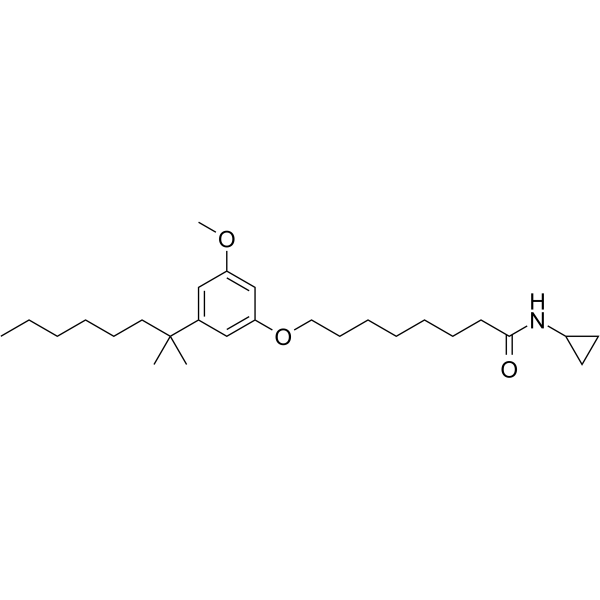CB1/2 agonist 4
Modify Date: 2024-01-12 16:05:37

CB1/2 agonist 4 structure
|
Common Name | CB1/2 agonist 4 | ||
|---|---|---|---|---|
| CAS Number | 2772949-38-7 | Molecular Weight | 431.65 | |
| Density | N/A | Boiling Point | N/A | |
| Molecular Formula | C27H45NO3 | Melting Point | N/A | |
| MSDS | N/A | Flash Point | N/A | |
Use of CB1/2 agonist 4CB1/2 agonist 4 (compound 24) is a full CB1 agonist and CB2 partial agonist with EC50 values of 15.09 nM and 1.16 nM, respectively. CB1/2 agonist 4 (compound 24) has a significant antinociceptive activity, and also can activate cannabinoid and TRPV1 receptor with values of IC50 and EC50 is 0.8 μM and 0.12 μM, respectively[1]. |
| Name | CB1/2 agonist 4 |
|---|
| Description | CB1/2 agonist 4 (compound 24) is a full CB1 agonist and CB2 partial agonist with EC50 values of 15.09 nM and 1.16 nM, respectively. CB1/2 agonist 4 (compound 24) has a significant antinociceptive activity, and also can activate cannabinoid and TRPV1 receptor with values of IC50 and EC50 is 0.8 μM and 0.12 μM, respectively[1]. |
|---|---|
| Related Catalog | |
| Target |
EC50: 15.09 nM (CB1); EC50: 1.16 nM (CB2); IC50: 0.8 μM, EC50: 0.12 μM (TRPV1) [1] |
| In Vitro | CB1/2 agonist 4 (compound 24) can induce a stimulation of [35S]GTPγS binding to hCB1-CHO cell membranes with an EC50 value of 15.09 nM. CB1/2 agonist 4 (compound 24) was able to slightly stimulate [35S]GTPγS binding to hCB2-CHO cell membranes, behaving as a weak partial agonist to CB2 receptors of 1.16 nM[1]. |
| In Vivo | CB1/2 agonist 4 (compound 24) (1, 3 and 4 mg/kg, i.p.) has a stronger antinociceptive activity.CB1/2 agonist 4 (compound 24) (1, 3 and 4 mg/kg, i.p.) can activate TRPV1 channel and it behaved as a good TRPV1 agonist with an IC50 value of 0.8 μM and EC50 value of 0.12 μM[1]. Animal Model: Male CD-1 outbred mice[1] Dosage: 1, 3 and 4 mg/kg Administration: 1, 3 and 4 mg/kg, i.p. Result: Significantly reduced the late phase of formalin-induced nociceptive behaviour in a dose dependent manner and slightly decreased also the first phase of nociceptive response. |
| References |
| Molecular Formula | C27H45NO3 |
|---|---|
| Molecular Weight | 431.65 |